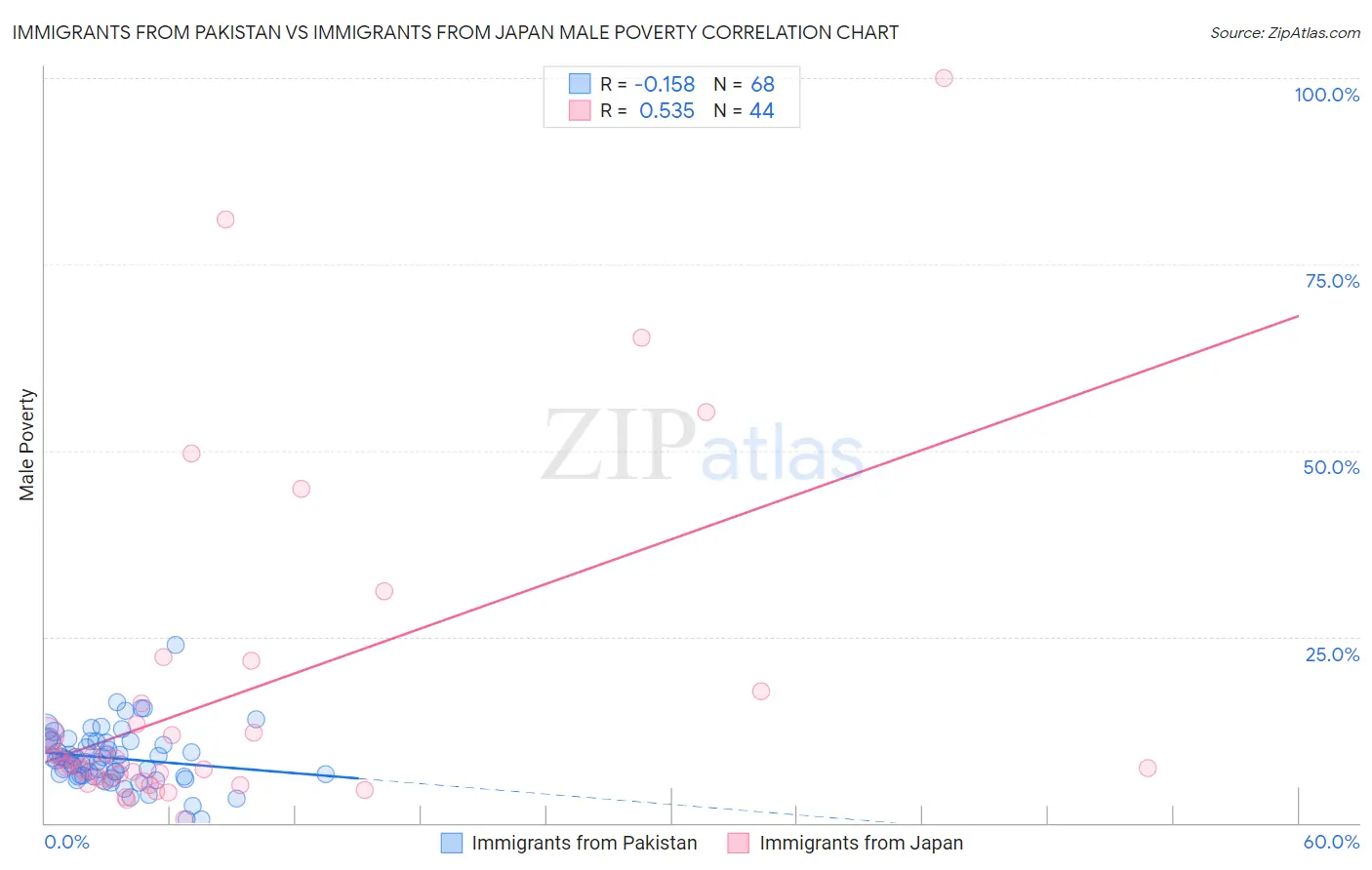Immigrants from Pakistan vs Immigrants from Japan Male Poverty
COMPARE
Immigrants from Pakistan
Immigrants from Japan
Male Poverty
Male Poverty Comparison
Immigrants from Pakistan
Immigrants from Japan
9.9%
MALE POVERTY
99.2/ 100
METRIC RATING
38th/ 347
METRIC RANK
10.0%
MALE POVERTY
98.8/ 100
METRIC RATING
48th/ 347
METRIC RANK
Immigrants from Pakistan vs Immigrants from Japan Male Poverty Correlation Chart
The statistical analysis conducted on geographies consisting of 283,757,026 people shows a poor negative correlation between the proportion of Immigrants from Pakistan and poverty level among males in the United States with a correlation coefficient (R) of -0.158 and weighted average of 9.9%. Similarly, the statistical analysis conducted on geographies consisting of 339,942,398 people shows a substantial positive correlation between the proportion of Immigrants from Japan and poverty level among males in the United States with a correlation coefficient (R) of 0.535 and weighted average of 10.0%, a difference of 1.2%.

Male Poverty Correlation Summary
| Measurement | Immigrants from Pakistan | Immigrants from Japan |
| Minimum | 0.49% | 0.45% |
| Maximum | 23.9% | 100.0% |
| Range | 23.4% | 99.6% |
| Mean | 8.7% | 16.8% |
| Median | 8.5% | 8.1% |
| Interquartile 25% (IQ1) | 6.3% | 5.8% |
| Interquartile 75% (IQ3) | 10.9% | 14.6% |
| Interquartile Range (IQR) | 4.6% | 8.8% |
| Standard Deviation (Sample) | 3.8% | 21.7% |
| Standard Deviation (Population) | 3.8% | 21.5% |
Demographics Similar to Immigrants from Pakistan and Immigrants from Japan by Male Poverty
In terms of male poverty, the demographic groups most similar to Immigrants from Pakistan are Russian (9.9%, a difference of 0.010%), Cypriot (9.9%, a difference of 0.090%), Korean (9.9%, a difference of 0.18%), Immigrants from Greece (9.8%, a difference of 0.37%), and Immigrants from Iran (9.9%, a difference of 0.42%). Similarly, the demographic groups most similar to Immigrants from Japan are Immigrants from Singapore (10.0%, a difference of 0.0%), Slovene (10.0%, a difference of 0.090%), Turkish (10.0%, a difference of 0.13%), Immigrants from Philippines (10.0%, a difference of 0.14%), and Immigrants from Serbia (10.0%, a difference of 0.15%).
| Demographics | Rating | Rank | Male Poverty |
| Immigrants | Northern Europe | 99.5 /100 | #33 | Exceptional 9.7% |
| Immigrants | Poland | 99.5 /100 | #34 | Exceptional 9.8% |
| Iranians | 99.4 /100 | #35 | Exceptional 9.8% |
| Czechs | 99.4 /100 | #36 | Exceptional 9.8% |
| Immigrants | Greece | 99.3 /100 | #37 | Exceptional 9.8% |
| Immigrants | Pakistan | 99.2 /100 | #38 | Exceptional 9.9% |
| Russians | 99.2 /100 | #39 | Exceptional 9.9% |
| Cypriots | 99.2 /100 | #40 | Exceptional 9.9% |
| Koreans | 99.2 /100 | #41 | Exceptional 9.9% |
| Immigrants | Iran | 99.1 /100 | #42 | Exceptional 9.9% |
| Immigrants | Moldova | 99.0 /100 | #43 | Exceptional 9.9% |
| Immigrants | Romania | 98.9 /100 | #44 | Exceptional 9.9% |
| Immigrants | Serbia | 98.9 /100 | #45 | Exceptional 10.0% |
| Turks | 98.9 /100 | #46 | Exceptional 10.0% |
| Immigrants | Singapore | 98.8 /100 | #47 | Exceptional 10.0% |
| Immigrants | Japan | 98.8 /100 | #48 | Exceptional 10.0% |
| Slovenes | 98.8 /100 | #49 | Exceptional 10.0% |
| Immigrants | Philippines | 98.7 /100 | #50 | Exceptional 10.0% |
| Immigrants | Croatia | 98.7 /100 | #51 | Exceptional 10.0% |
| Asians | 98.7 /100 | #52 | Exceptional 10.0% |
| Immigrants | Czechoslovakia | 98.6 /100 | #53 | Exceptional 10.0% |